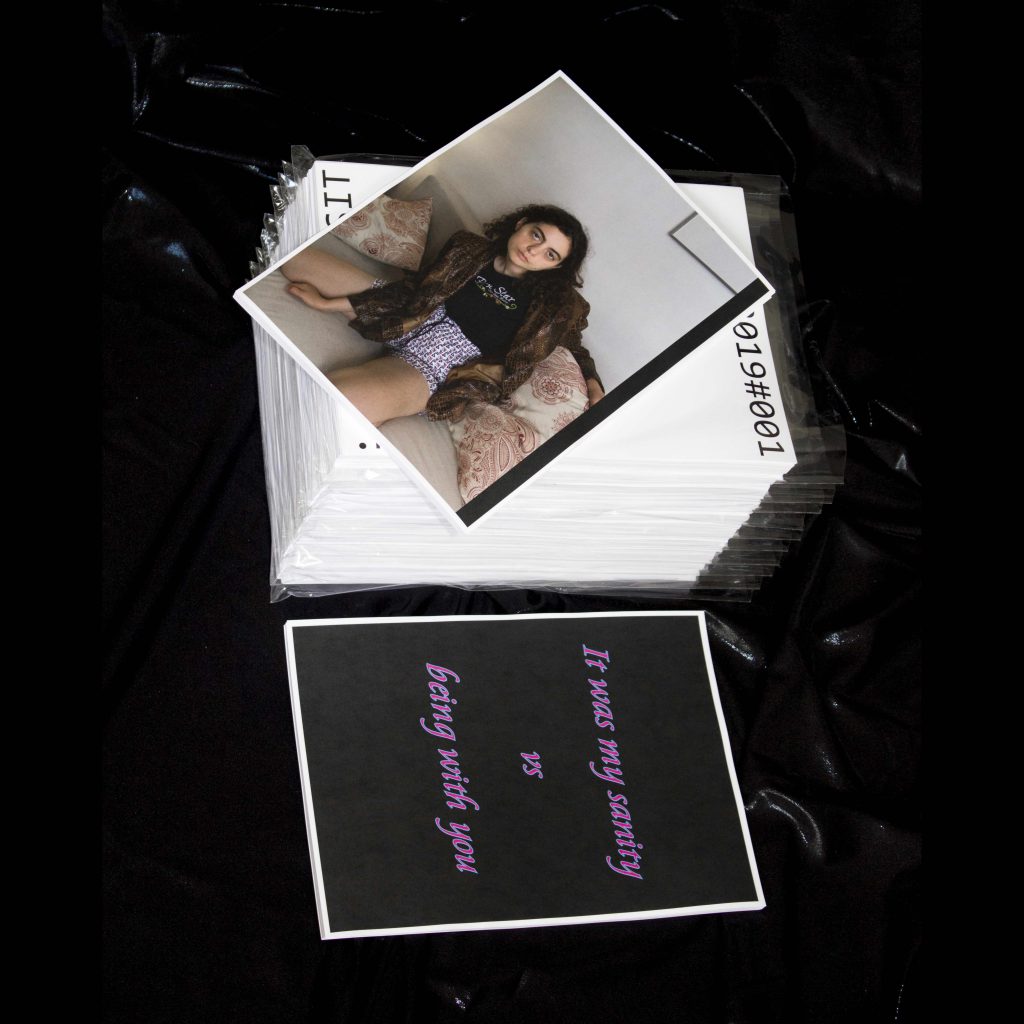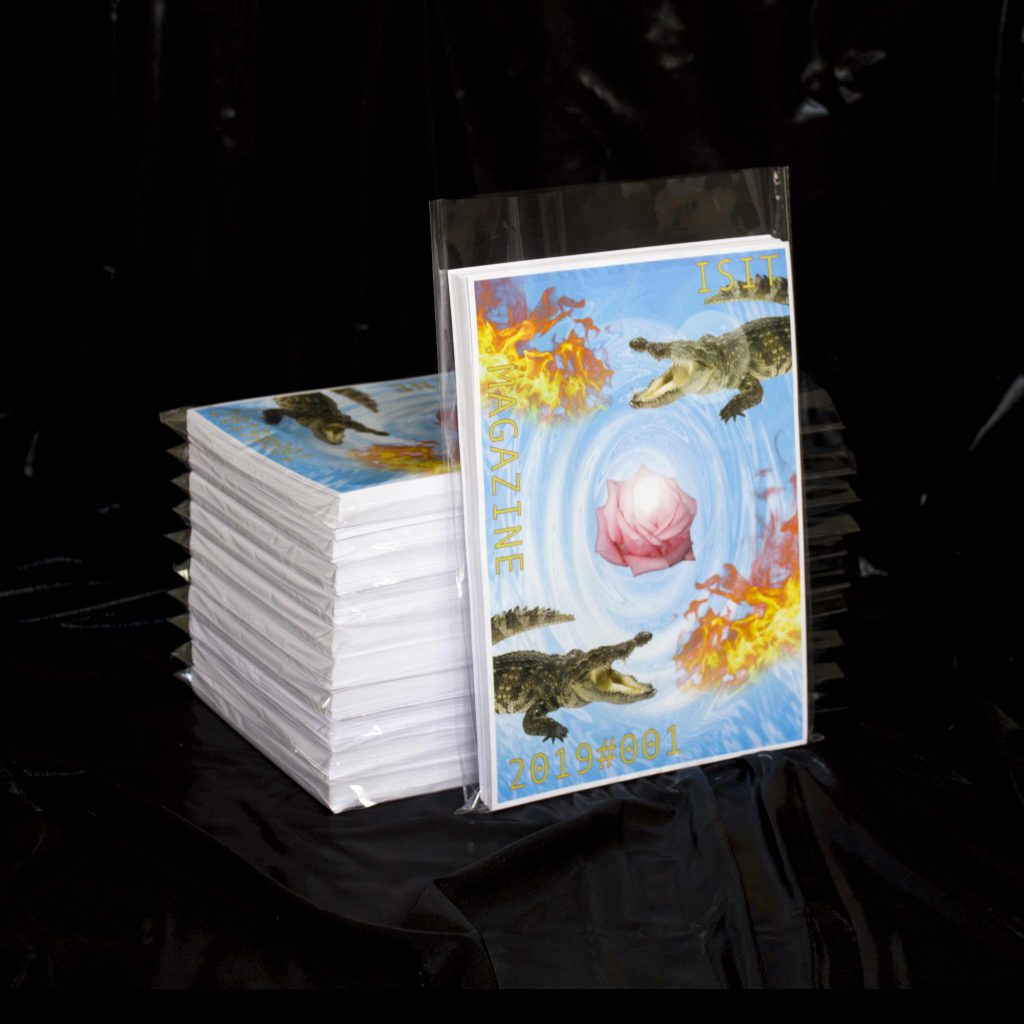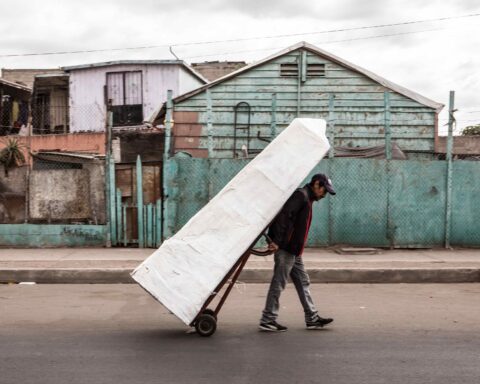ISIT.magazine is a fluid reality in which heterogeneous entities converge, deposits of the sacred fire of art and of that light bulb that once lit, illuminates the world. Outside the box, the brilliant artistic project of Federica Di Pietrantonio and Andrea Frosolini, born in September 2019, plays with the perception of classic editorial dimension and destroys the rigid canonical construction of the magazine, giving rise to a noun of short circuits, unexpected situation and paradoxes, that emanates magical sparks. In an evolutionary path of reworking and updating of tradition ISIT.magazine, in both his on-line/off-line versions, one on the net and the other on paper, becomes a revolutionary symbol and a place for meeting and sharing experiences where art is no longer just on display but it can be lived and experimented directly on the skin. The interaction and the interactivity, that determine a new type of use, are indispensable ingredients for the construction of a dynamic alternative of meaning and narration, that allows to get closer and enter in the cryptic issues of art, in its fruition and the information it conveys. It is precisely a more lucid and disenchanted look that ISIT invites the reader to operate, aimed at reigniting the mechanisms of critical thinking; questioning and reflecting with irony and lucidity, even surprising itself sometimes, are actions that must not to be forgotten or avoided, but rather encouraged because only in this way is it possible to know the systems and the networks that regulate the life, and the true change that can be implemented towards the non-technological progress, wise and with consciousness. The following interview with the founders of ISIT.magazine was born from the intention to deepen and highlight both the dynamics and the problems implicit in the implementation of a creative process and the importance of questioning on issues about reality, art and life.

Erica Cammerata: What is ISIT? How would you describe yourself (the project) in three words?
AFFDP: ISIT was born as an on-line/off-line platform, ISIT wants to be, for those who are hosted, a totally free and open space. The project is declined in various forms: magazine, website, socials and merchandising. The aspect we are mostly interested in is precisely not to be restrained into a single type of medium, but to re-evaluate the content and format each time. An aspect we are interested in is the language of popular platforms, that we both use and make fun of. We never take ourselves seriously, we joke around with seriousness.
E.C. Three words?
AFFDP: Sun, heart and love.
E.C. How was ISIT.magazine born? And what motivated you to start this project that challenges the conventional rules of traditional publishing?
AFFDP: ISIT caught us at a time when we weren’t physically together, but separated between Belgium and Rome, and still completely unaware. We were on the phone having surreal conversations about what it could be, how and why. We didn’t actually have the intention of creating a magazine, we wanted to create a real and virtual space for the promotion and display of contemporary art, in and out of the spotlight. Especially for what it was out of the spotlight.
E.C. What is/are the ISIT’s purpose/s?
AFFDP: We want our artists to interact with the medium without any kind of restriction or constraint. As publishers we don’t want to contaminate any project with our vision, no more than what already happens naturally with the selection, the communication and the final realization of the product. The name ISIT comes from questioning and never defining yourself. Knowing how not to be.
E.C. What could I come across when reading ISIT. magazine?
AFFDP: Photographic projects, interviews, critical texts, photo novels, stories, legendary Pokémon, graphic projects, conversations, spam, advertising, images, true and/or untrue stories, gossip, rubrics, artists, Vasco Rossi, sushi and sashimi, posters, prohibited photos, queer stuff, emojis, essays, nostalgia, fabulousness, chills, emotions, romance, decay, irony, cynicism, fractals, acids, murders, betrayals, honor and respect, art, fresh fruit, brush script, consolas, cigarettes, hankies, bondage, illustrations and Lana Del Ray.
E.C. What are the themes and subjects you favour when choosing contents?
AFFDP: Most of the contents of the magazine come to us from artists that we select through open calls. As soon as we started working on ISIT, we had the idea of making one. From our point of view it was a way to get a response from the audience about the concept and to find artists we wouldn’t have known otherwise. The only requirement for our open calls is a portfolio. The collaboration with us starts only after the actual selection, without a set topic. This made the magazine a work in progress. Not having a particular request, we were looking for an answer from contemporary art’s audience towards contemporary art itself.
E.C. How is the magazine structured and how is the reading of the printed edition different from that available on the web?
AFFDP: The magazine is a collection of artist’s projects, photographers, illustrators, graphic designers, writers, curators, journalists, critics and tattoo artists. For the first issues we decided to insert the projects consecutively, the edition isn’t bound and the pages aren’t numbered. The idea is to be able to break the narrative, so that everyone can create their own. Nothing but 66% of a stock of Moldmade paper. The online and offline versions are one translation of the other. The contents are equally present in both, it is the system of fruition that changes. We didn’t want the online magazine to be just a transcription of the printed one, but to offer an experience related to its medium.

E.C. About the layout of the online page, what does the presence of a light-interruption which appears every time you click on a content represent?
AFFDP: We wanted the website not to offer just the classic experience of information scrolling. The website is designed with the same concept as the printed magazine, not following the regular flow of reading. We wanted to give users and readers the possibility to choose their own type of navigation and mess around with their heads a bit.
E.C. Speaking of duration, how often is the magazine published and how often do you add new content on both digital and physical formats?
AFFDP: The release of both formats happens simultaneously on an annual basis. We use the website for our definitive publication, not as a means of communication. This means the content remains unmodified throughout the entire year, during which we advertise them through different channels. An exception might be one of our last open calls, which winners customized the cover of ISIT2019#001, subsequently published both on paper and online.
E.C. What was the most difficult challenge you faced for the creation of ISIT.magazine?
AFFDP: We never thought of challenges as such, being accustomed to living the life of a young artist in the contemporary art system. We approached the magazine in the exact same way we approach a work of art, the constant challenge is to keep the rhythm. Work it good.
E.C. Could you tell me a funny or unexpected episode in which you came across during the realization of the magazine’s concept?
AFFDP: We were in Ghent for the installation of one of our exhibitions, and on that occasion we made various studio visits and interviews. At 4 a.m. we were moshing hard at the Kinky Bar together with the first artist we interviewed (who didn’t know she broke a finger of one of us)
Oopsy.
E.C. Why did you feel the need to change the rules and go beyond the known world of canonical publishing and try your hand at a project so far from tradition?
AFFDP: More than a need, it was a consequence. By relating to art daily as artists, it was natural for it not only to include the typical contents of a magazine (interviews, articles, etc…) but real artist’s projects, which are designed specifically to live on the page and in particular on ISIT. In this way we see the magazine as a real space, aka- translation of a whitecube on paper. Somehow perhaps a conceptual reversal takes place, as a space that is not conventional for journalism at the same time becomes conventional for contemporary art. ISIT ISNT.
E.C. What do you hope/think is the answer or reaction of readers who follow the magazine?
AFFDP: We hope that readers appreciate ISIT’s identity, without necessarily creating superstructures to its unconventionality. ISIT is, after all, a contemporary art magazine, but we like that the audience comes from different cultural backgrounds. We think the answer is we are at the same time amused, but aware. We flirt with the medium and the public. The library is open.
E.C. What are your long-term resolutions and where do you think the future will take you?
AFFDP: Our attitude is to always question ourselves as a magazine. ISIT could be defined as an ambitious and rational project. We are truly satisfied with its performance, considering it was born only in September 2019, we still have many projects in progress and in the pipeline. We are currently working on ISIT2020#002, new projects keep coming in also through the opencall#002 which will expire on May 1st. As of a few months ago we started to participate in various fairs, we have been to Yami-Ichi internet in Bologna and the Paper Market Fair in Rome, this has pushed us not only to work on the editorial production of the magazine but also present other productions, which can vary from the zine to the so-called pirate. The methodology of our work leads us not to think too much about the future, we take the opportunities that come to us and create new ones. Be fab without any effort.









